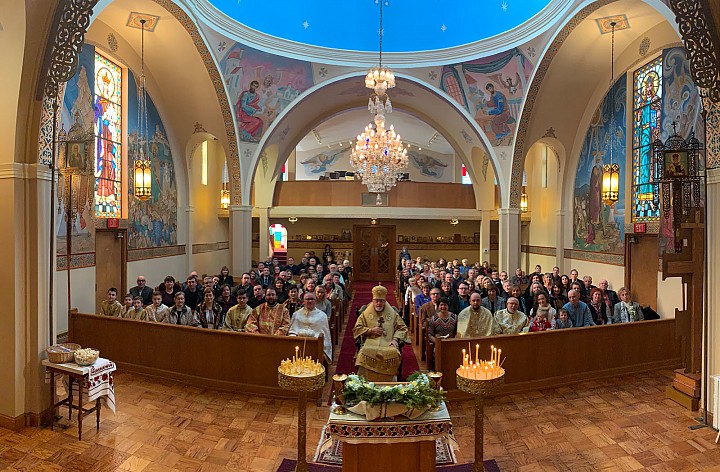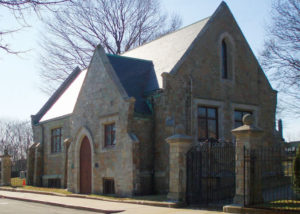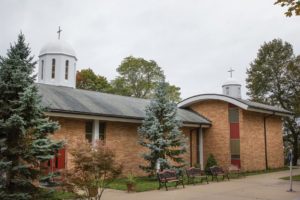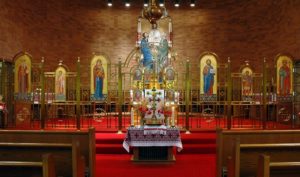
31 May 2022 Ukraine in Boston’s Architectural Landscape
The war in Ukraine has called attention to the small but important concentration of Ukrainians-Americans in Boston. Their nearly 140-year arc of immigration has given the city several distinctive places and buildings emblematic of the Ukrainian experience.
The stone chapel, mausoleums and gravestones of Ohabei Shalom Cemetery at 147 Wordsworth Street in East Boston is a reminder that the neighborhood’s Jewish population grew from 5000 to 40,000 in late 19th century with the massive influx of Jewish refugees from the Russian empire and Eastern Europe, including the city of Odessa in southern Ukraine.  The oldest Jewish cemetery in Massachusetts, it was formed in 1844 by mostly German and Polish Jews. However, Ohabei Shalom’s grave
The oldest Jewish cemetery in Massachusetts, it was formed in 1844 by mostly German and Polish Jews. However, Ohabei Shalom’s grave  configurations, Hebrew/Yiddish inscriptions, and grave marker iconography derive inspiration from European Jewish burial customs, reflecting the range of Jewish immigrants over the 19th and 20th centuries and the countries from which they emigrated. Much like the early 19th century garden style cemeteries of Mount Auburn and Forest Hills, the cemetery was important open space in the 19th century. An 1886 City map “Public Recreation Grounds and Certain other Public Properties Generally Free from Buildings” noted the cemetery as “available to be used as [a] breathing place or recreation ground.”
configurations, Hebrew/Yiddish inscriptions, and grave marker iconography derive inspiration from European Jewish burial customs, reflecting the range of Jewish immigrants over the 19th and 20th centuries and the countries from which they emigrated. Much like the early 19th century garden style cemeteries of Mount Auburn and Forest Hills, the cemetery was important open space in the 19th century. An 1886 City map “Public Recreation Grounds and Certain other Public Properties Generally Free from Buildings” noted the cemetery as “available to be used as [a] breathing place or recreation ground.”
Although no longer an active burial location, Ohabei Shalom Cemetery is under the auspices of the Jewish Cemetery Association of Massachusetts (JCAM) which manages and maintains it. Most recently, JCAM has planned a Jewish heritage and cultural center in the cemetery’s 1903 chapel building.
In Boston’s Forest Hills neighborhood, two Ukrainian churches — one Catholic and one Orthodox – were built in the latter half of the 20th century to support first and second generation Ukrainians who had concentrated in Jamaica Plain, Roslindale, Mattapan and Hyde Park.

Christ the King Ukrainian Catholic Church was built in 1971 at 146 Forest Hills Street in Jamaica Plain on the former Ross family estate, a property that the Ukrainian Catholic congregation of Sacred Heart had purchased in 1950 and only partially developed. The modernist church was built for the newly formed congregation of Christ the King, forged from two Ukrainian Catholic congregations – Sacred Heart and St. George’s – that had previously splintered over ecclesiastical matters. The two congregations were re-united in the late 1960s under a new name and an agreement to build a new church building.
Ross family estate, a property that the Ukrainian Catholic congregation of Sacred Heart had purchased in 1950 and only partially developed. The modernist church was built for the newly formed congregation of Christ the King, forged from two Ukrainian Catholic congregations – Sacred Heart and St. George’s – that had previously splintered over ecclesiastical matters. The two congregations were re-united in the late 1960s under a new name and an agreement to build a new church building.
Built atop the hilly property overlooking Forest Hills Street, Christ the King was designed by architect Laurence Cuneo of Malden, who had also designed Our Lady of the Annunciation Melkite church in West Roxbury in 1966 with a similar modernist-Byzantine flavor.
Only several blocks away, St. Andrew Ukrainian Orthodox Church at 24 Orchard Hill Road in Jamaica Plain, is home to the Ukrainian Orthodox Christian congregation formed in 1954 from the post-World War Two concentration of Ukrainians that had moved to the southern part of the city.
 The building dates to 1958 and is inspired by the 18th century Church of Saint Andrew in Kiev, with the traditional Byzantine-Slavic design expression of five onion domes. The architect was Ukrainian-born George Kodak, who had trained in Kiev and emigrated to Canada after World War Two. He is credited with the designs of several Ukrainian Orthodox churches in the US and Canada. The interior of St. Andrew is richly decorated with iconographic paintings on the walls and on the icon screen at the church’s altar.
The building dates to 1958 and is inspired by the 18th century Church of Saint Andrew in Kiev, with the traditional Byzantine-Slavic design expression of five onion domes. The architect was Ukrainian-born George Kodak, who had trained in Kiev and emigrated to Canada after World War Two. He is credited with the designs of several Ukrainian Orthodox churches in the US and Canada. The interior of St. Andrew is richly decorated with iconographic paintings on the walls and on the icon screen at the church’s altar.
Both Christ the King and St. Andrew draw recent immigrants and Americans of Ukrainian descent, most of whom now live in Boston’s suburbs. They also continue religious and cultural expressions of Ukraine in their choral traditions, foodways, language and dance.
While there may no longer be a large population of Ukrainian origin within the city limits, their presence is still felt in the institutions, traditions and places they continue to steward in Boston’s neighborhoods.
(Featured image: St. Andrew Ukrainian Orthodox Church congregation with Metropolitan Antony celebrate the 60th anniversary of the church building in Jamaica Plain)



